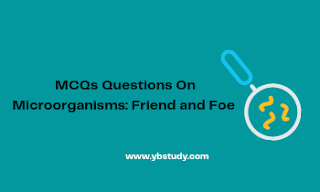Class 8 Science Chapter 2 MCQs
MCQ Questions for Class 8 Science Chapter 2 Microorganisms: Friend and Foe with Answers pdf
Microorganisms are too small and are not visible to the unaided eye. They can live in all kinds of environment,ranging from ice cold climate to hot springs and deserts to marshy lands. Microorganisms are found in air, water and in the bodies of plants and animals. They may be unicellular or multicellular. Microorganisms include bacteria, fungi,protozoa and some algae. Viruses, though different from the above mentioned living organisms, are considered microbes. Viruses are quite different from other microorganisms. They reproduce only inside the host organism: bacterium, plant or ani-mal cell. Some microorganisms are useful for commercial production of medicines and alcohol.
Here Below we provide a list of microorganisms: Friend and foe MCQ outlined by experts who suggest the most important MCQ for various competitive exams. The below MCQ takes you directly to the corresponding topic where the detailed article along with MCQs is provided for a smooth, effortless searching experience. Before going ahead to solved MCQ question for class 8 science chapter 2 papers or taking up mock tests, make sure you cover the basic concepts of science.
Science Quiz For Class 7 Chapter 2
1. The breakdown of complex components of food into simpler substances is called__________
(a) ingestion
(b) egestion
(c) assimilation
(d) digestion
Answer: (d)
2. Which of the following animals swallow its prey?
(a) Human beings
(b) Snakes
(c) Humming birds
(d) Ant
Answer: (b)
3. From where do we take in food?
(a) Anus
(b) Mouth
(c) Stomach
(d) Oesophagus
Answer: (b)
4. The teeth of first set fall off at the age between_______________
(a) 10 – 20
(b) 6 – 8
(c) 9 – 1
(d) 0 – 2
Answer: (b)
5. The process of taking food in the body is known as____________
(a) egestion
(b) ingestion
(c) digestion
(d) assimilation
Answer: (b)
6. Starch is broken down into sugars by the action of________________
(a) saliva
(b) bile juice
(c) hydrochloric acid
(d) all of these
Answer: (a)
7. The removal of faeces through the anus from time to time is called__________
(a) rumination
(b) micturition
(c) ingestion
(d) egestion
Answer: (d)
8. The finger-like outgrowths of human intestine helps to______________
(a) make the food soluble
(b) absorb the digested food
(c) absorb the undigested food
(d) digest the fatty food substances
Answer: (b)
9. Many animals, including humans, cannot digest________________
(a) amino acid
(b) bile juice
(c) cellulose
(d) proteins
Answer: (c)
10. Which of the following are called the cutting teeth?
(a) Incisors
(b) Canines
(c) Molars
(d) Premolars
Answer: (a)
11. The digestive food is absorbed in______
(a) large intestine
(b) stomach
(c) liver
(d) small intestine
Answer: (d)
12. Transport Of Digested And Soluble Food From The Intestine To Blood Vessels”is known as______________
(a) Large intestine
(b) Absorption
(c) Assimilation
(d) Digestion
Answer: (b)
13. There Are Given Some Parts Of Digestive System, Choose The Odd One Out:
(a) Stomach
(b) Liver
(c) Pancreas
(d) Salivary gland
Answer: A
14. The Enzymes Present In The Saliva Convert____________
(a) Fats into fatty acids and glycerol.
(b) Starch into simple sugars.
(c) Proteins into amino acids
(d) Complex Sugars into simple sugars
Answer: (b)
15. Curd Is The Name Given To The Food Of Ruminants Which is____________
(a) Swallowed and undigested
(b) Swallowed and partially digested
(c) Properly chewed and partially digested
(d) Properly chewed and completely digested
Answer: (b)
16. In Which Of The Statements Is Or Are Incorrect, About Eating Habits Of Animals?
(a) Animals that obtain their food by killing other animals, called scavengers.
(b) Organisms that obtain their food from other animals either by living inside or outside their body, called parasite.
(c) Animals that consume plants as well as other animals as their food, called omnivorous.
(d) Animals that obtain their food only from plants, called herbivorous.
Answer: (a)
17. ______is the largest gland in the body ?
(a) Lungs
(b) Liver
(C) kidney
(d) Heart
Answer: (b)
18. The bile juice secreted from the ____ ?
(a) Pancreas
(b) Heart
(c) Liver
(d) kidney
Answer: (c)
19. Which one of the following is not secreted in the stomach?
(a) HCl
(b) Pepsin
(c) Trypsin
(d) Mucus
Answer: (c)
20. Which enzyme helps in transfer of Trypsinogen to trypsin secreted from the walls of the small intestine?
(a) Proteinase
(b) Enterokinase
(c) Amylase
(d) Lactase
Answer: (b)
21. The process of chewing of food is called______________
(a) Digestion
(b) Ingestion
(c) Mastication
(d) Emulsification
Answer: (c)
22. The inner walls of the small intestine have millions of small finger like projections called___________
(a) villi
(b) trachae
(c) appendix
(d) oesophagus
Answer: (a)
23. These are blood sucking parasites.
(a) Earthworm
(b) Hookworm
(c) Leeches
(d) Caterpillar
Answer: (c)
24. Oesophagus is also known as________–
(a) Food pipe
(b) Digestive tract
(c) Wind pipe
(d) Food regulator
Answer: (a)
25. The movement of food in food pipe is called___________
(a) Linear movement
(b) Rectilinear movement
(c) Smooth movement
(d) Peristaltic movement
Answer: (d)
26. Insects suck the food in liquid form with the help of _________
(a) Deprogram
(b) Proboscis
(c) Tentacles
(d) Tongue
Answer: (b)
27. The semi-solid mass which is produced after thoroughly mix up of food and gastric juice is called____________
(a) bolus
(b) chyme
(c) bile
(d) villus
Answer: (b)
28. Amoeba obtains the food using a finger-like projection called _________
(a) Pseudopodia
(b) Spiracles
(c) Diaphragm
(d) Mouth
Answer: (a)
29. Nutrients digested by amoeba are______
(a) Sugar
(b) Cellulose
(c) Protein
(d) All of the above
Answer: (d)
30. Enzymes which helps in digestion in amoeba.
(a) Amylase
(b) Proteinase
(c) both (a) and (b)
(d) None of the above
Answer: (c)
